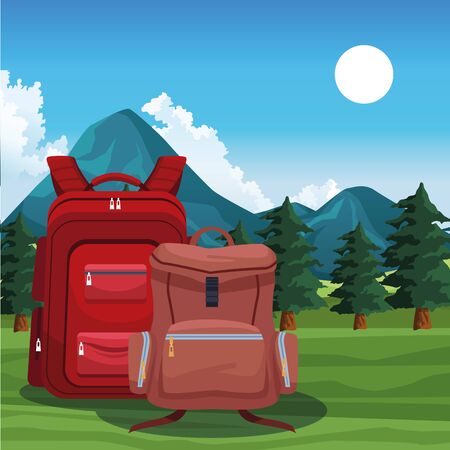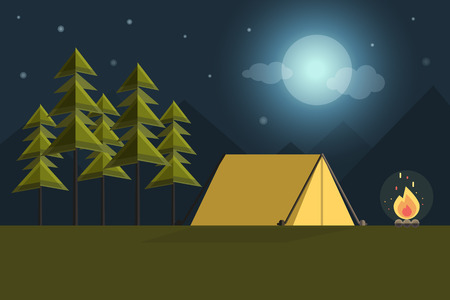Introduction: The Importance of Weather on Backpacking Adventures
Backpacking across the United States is an adventure that promises breathtaking vistas, diverse terrains, and unforgettable memories. Yet, every seasoned backpacker knows that climate and weather conditions are more than just a backdrop—they are central characters in your journey. From the arid deserts of Arizona to the rain-soaked forests of the Pacific Northwest, understanding local climate patterns is crucial for planning safe and enjoyable trips. Weather can shape everything from what gear you pack to which trails are accessible, impacting both your comfort and safety. Embracing the dynamic nature of U.S. landscapes means respecting the power of Mother Nature and preparing accordingly. Whether you’re chasing wildflower blooms in spring or tackling snow-capped peaks in winter, knowing how to interpret weather forecasts and seasonal trends can transform your outdoor experience, ensuring every step is as rewarding as it is memorable.
2. Regional Climate Differences Across the States
One of the most captivating aspects of backpacking in the U.S. is the sheer diversity of its climate zones, each shaping outdoor adventures in distinct ways. From the sun-soaked deserts of the Southwest to the lush, humid forests of the Southeast, understanding these regional differences is key to planning a successful trip. The U.S. landscape is like a natural patchwork quilt—each region presents unique weather patterns that can elevate or challenge your backpacking experience.
Unique Climate Zones and Their Backpacking Impact
| Region | Climate Characteristics | Backpacking Considerations |
|---|---|---|
| Southwest (e.g., Arizona, New Mexico) | Arid, hot days, cool nights, low humidity | Lightweight gear needed for heat; water scarcity is a major concern; watch for flash floods during monsoon season |
| Southeast (e.g., Florida, Georgia) | Humid, frequent rainfall, warm temperatures year-round | Packing for rain and humidity is essential; insect protection is a must; trails can be muddy and slippery |
| Pacific Northwest (e.g., Washington, Oregon) | Mild summers, wet winters, frequent drizzle | Waterproof clothing and quick-drying layers are crucial; mossy landscapes create slippery terrain; daylight hours vary greatly by season |
| Northeast (e.g., Maine, Vermont) | Cold winters, warm summers, seasonal foliage changes | Packing layers for variable temps; autumn offers breathtaking views but cooler nights; black flies and mosquitoes are prevalent in late spring and summer |
| Rocky Mountains (e.g., Colorado, Montana) | Cooler temps at elevation, sudden weather shifts, snow possible even in summer | Be prepared for four seasons in one day; altitude sickness is a risk; carry extra insulation and storm-ready gear |
The Art of Adapting to Local Conditions
Your backpacking journey transforms with each region’s climate. In the Southwest’s arid expanses, minimalist packing and hydration strategies are non-negotiable. In contrast, lush Appalachian trails demand waterproof gear and careful planning around thunderstorms. The Pacific Northwest asks for your patience with persistent drizzle but rewards you with emerald-green scenery. Each zone invites you to tune into nature’s rhythm—packing smart and embracing the distinctive character of America’s great outdoors.

3. Seasonal Considerations: When to Hit the Trail
Backpacking in the U.S. is a dance with the seasons, each one offering its own mood and challenges across the country’s diverse landscapes. Spring is an inviting time in many southern regions like the Smoky Mountains or the Ozarks, where wildflowers bloom and temperatures are pleasantly mild—though spring showers can turn trails muddy and creeks swift, so waterproof gear is a must. Summer opens up the alpine magic of the Rockies and Sierra Nevada, with long daylight hours and snow-free passes making high-elevation adventures possible. However, it’s also the peak season for afternoon thunderstorms and, in some areas, wildfire risks. In contrast, backpackers in the Southwest desert regions like Utah or Arizona should avoid summer due to extreme heat; instead, late fall or early spring offer cooler days and quieter trails.
Autumn brings crisp air and vibrant foliage to New England and the Appalachians—a favorite for leaf-peepers seeking golden forests under clear skies. Meanwhile, shoulder seasons (late spring and early fall) are ideal in Pacific Northwest locales such as Olympic National Park, when rainfall lessens but lush greenery remains. Winter can be magical for experienced backpackers prepared for snow camping in places like Yosemite or Colorado’s backcountry, but shorter daylight hours and unpredictable storms demand extra caution. Ultimately, choosing when to hit the trail means matching your destination with its seasonal sweet spot—balancing comfortable temperatures, manageable precipitation, and those precious golden hours of sunlight that make every mile memorable.
4. Weather Hazards: What to Watch Out For
When backpacking in the U.S., understanding and preparing for weather hazards is essential. America’s vast and varied landscapes expose backpackers to a spectrum of risks, from sudden flash floods in desert canyons to wildfires sweeping through forest trails, blizzards blanketing mountain passes, and fierce thunderstorms rolling across open plains. Each hazard demands awareness, preparation, and respect—both for nature’s power and your own limits.
Flash Floods
Flash floods are especially dangerous in regions like the Southwest, where narrow slot canyons can funnel water rapidly after a rainstorm miles away. Even if the sky above you is clear, upstream rainfall can trigger a torrent within minutes. For example, hikers in Utah’s Zion National Park have been caught off guard by flash floods that turned calm streams into raging rivers. Always check local weather advisories before entering canyon areas and avoid hiking during or after heavy rain.
Wildfires
In dry seasons, especially throughout California, Colorado, and the Pacific Northwest, wildfires pose significant threats to both safety and air quality. Sudden wind shifts can cause fires to spread unpredictably. In 2020, backpackers on the Pacific Crest Trail had to evacuate sections near Oregon as flames advanced rapidly. Stay updated with fire reports, carry an N95 mask for smoke protection, and always have an alternative exit route planned.
Blizzards
High-elevation regions like the Rockies or Sierra Nevada are prone to intense winter storms and blizzards, often arriving with little warning. Whiteout conditions can disorient even experienced backpackers, while subzero temperatures increase risk of hypothermia. A real-life lesson comes from Appalachian Trail hikers who’ve been stranded due to unanticipated snowstorms in early spring or late fall. Pack extra insulation layers, emergency blankets, and always let someone know your route.
Thunderstorms
The Midwest and Southeast see frequent thunderstorms, sometimes bringing hail, lightning strikes, or tornadoes. Open spaces—like those along the Great Plains—offer little shelter. Lightning poses a particular danger; in Colorado’s Rocky Mountain National Park, hikers have been injured by strikes on exposed ridgelines. If thunder rumbles nearby, descend below treeline immediately and avoid isolated trees or metal gear.
Quick Reference Table: Common U.S. Backpacking Weather Hazards
| Hazard | Common Regions | Main Risks | Preparedness Tips |
|---|---|---|---|
| Flash Floods | Southwest Canyons | Drowning, entrapment | Check forecasts; avoid narrow canyons after rain |
| Wildfires | West Coast, Rockies | Burns, smoke inhalation | Monitor fire alerts; carry mask; plan escape routes |
| Blizzards | Mountain Ranges (Rockies/Sierra) | Hypothermia, disorientation | Pack warm gear; inform contacts; know exit points |
| Thunderstorms | Midwest/Plains/Southeast | Lightning strikes, hail | Avoid high ground; seek shelter early; minimize metal exposure |
Cultural Note:
The American ethos of “be prepared” is more than just a Boy Scout motto—it’s vital for safe backpacking. Checking NOAA weather updates and carrying basic emergency gear has become second nature for seasoned U.S. hikers. Respect for both local climate patterns and personal limits will ensure your adventure is memorable for all the right reasons.
5. Gear and Packing Tips for Changing Conditions
When backpacking across the diverse landscapes of the U.S., unpredictable climate and rapidly shifting weather are part of the adventure. Packing for such variability is both an art and a science—one that calls for thoughtfully chosen, multi-purpose gear and clothing. Start with the basics: invest in a high-quality layering system. Opt for moisture-wicking base layers that dry quickly, lightweight insulating mid-layers like down or synthetic jackets, and a waterproof yet breathable outer shell to shield you from rain, wind, and sudden temperature drops.
Versatility is your best friend on American trails. Convertible pants and zip-off sleeves give you flexibility as temperatures rise and fall. A packable rain jacket ensures you’re never caught off guard by unexpected storms, whether you’re hiking the misty Pacific Northwest or the unpredictable Appalachian Mountains. Don’t forget a wide-brimmed hat for sun protection and a pair of gloves for chilly mornings at higher elevations.
Smart packing means considering not only comfort but also safety. A compact emergency blanket can double as extra insulation or a shelter in case of sudden cold snaps. Always include a dry bag or waterproof stuff sack to keep your essentials safe from downpours or river crossings—a must in regions prone to summer thunderstorms or spring meltwater. For footwear, bring sturdy, quick-drying hiking boots or shoes with solid traction, plus an extra pair of socks to keep your feet dry through muddy trails or unexpected showers.
Finally, remember that preparation is key: always check local weather forecasts before heading out, but be ready for surprises. Flexible packing doesn’t just enhance comfort—it ensures you stay safe while fully embracing the wild beauty and ever-changing moods of America’s great outdoors.
6. Local Culture: How Americans Embrace the Elements
Backpacking across the United States is not just about traversing landscapes—its a celebration of regional traditions, shared wisdom, and trail etiquette shaped by local climate and weather patterns. From the sun-soaked deserts of the Southwest to the misty forests of the Pacific Northwest, American backpackers have developed unique approaches to navigating their environments, creating a vibrant culture rooted in respect for nature and community.
Desert Mindfulness in the Southwest
In places like Arizona and Utah, backpackers are deeply attuned to the harsh realities of arid climates. Early morning starts, siestas during peak heat, and meticulous water planning are common practices. Trail communities here emphasize Leave No Trace principles with heightened awareness—protecting fragile cryptobiotic soils and packing out every trace of waste is considered an essential code of conduct.
Pacific Northwest: Rain-Ready Rituals
The lush trails of Washington and Oregon are famous for their persistent drizzle and unpredictable showers. Locals have perfected layering systems and embrace waterproof gear as a matter of pride. The tradition of “trail magic”—unexpected acts of kindness from fellow hikers or locals—often includes offering dry socks or warm drinks, fostering a spirit of camaraderie that’s as cozy as it is practical.
High Country Traditions in the Rockies
Mountain weather demands quick adaptation. In Colorado, afternoon thunderstorms are a given, so early summit bids are part of the collective wisdom. Community forums buzz with real-time weather updates, while experienced hikers share knowledge about lightning safety and altitude acclimatization. Respect for rapidly changing conditions is woven into local trail etiquette—yielding to others on narrow passes and checking in at ranger stations are small rituals that build trust among trekkers.
Southeastern Resilience: Humidity and Hospitality
Backpacking through Appalachia or the Smokies means embracing humidity, summer storms, and muddy paths. Here, sharing bug spray or a tip about the nearest dry shelter is common courtesy. Hikers bond over tales of sudden downpours and slippery climbs, while seasoned locals teach newcomers how to spot wild edibles or safely navigate swollen streams after rain.
A Shared Spirit: Weather-Wise Wisdom
No matter where you roam in the U.S., backpacking culture reflects an adaptive spirit shaped by climate challenges. Regional traditions aren’t just survival strategies—they’re invitations to connect more deeply with place and people. Whether swapping stories around a campfire or lending a hand on a stormy day, American backpackers embody resilience, resourcefulness, and an enduring sense of community under ever-changing skies.
7. Conclusion: Navigating Nature’s Variety on U.S. Trails
Backpacking across the United States is an invitation to experience nature in all its dazzling diversity. From the misty peaks of the Pacific Northwest to the arid canyons of the Southwest, each trail offers a unique climate and weather pattern that shapes not just the landscape, but also your adventure. Respecting this variability is more than a matter of safety—it’s about embracing a deeper connection with the land and understanding its rhythms. Savvy backpackers know that preparation goes hand-in-hand with exploration. By staying informed, packing smart, and adapting to shifting conditions, you ensure your journey remains memorable for all the right reasons. So, as you lace up your boots and set out onto America’s wild trails, let curiosity lead you—but let respect for nature’s unpredictability guide every step. With an adventurous spirit and a well-prepared mindset, you’re ready to write your own story on some of the world’s most iconic paths.

